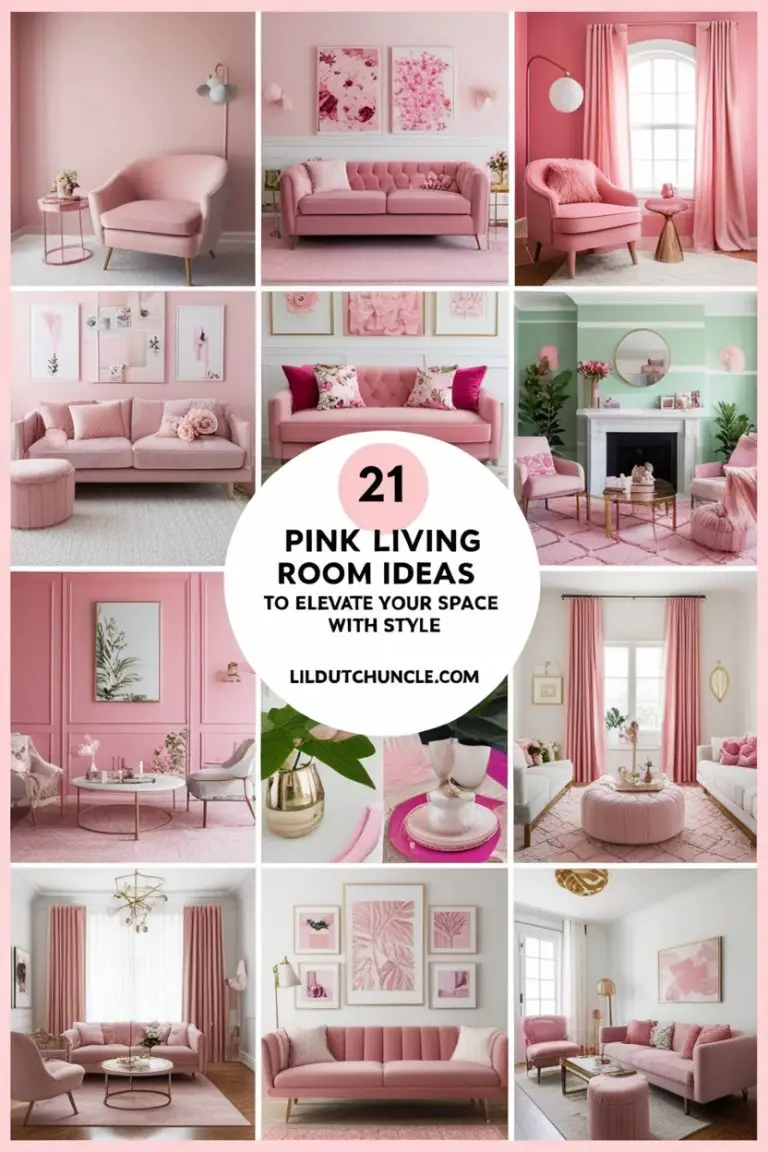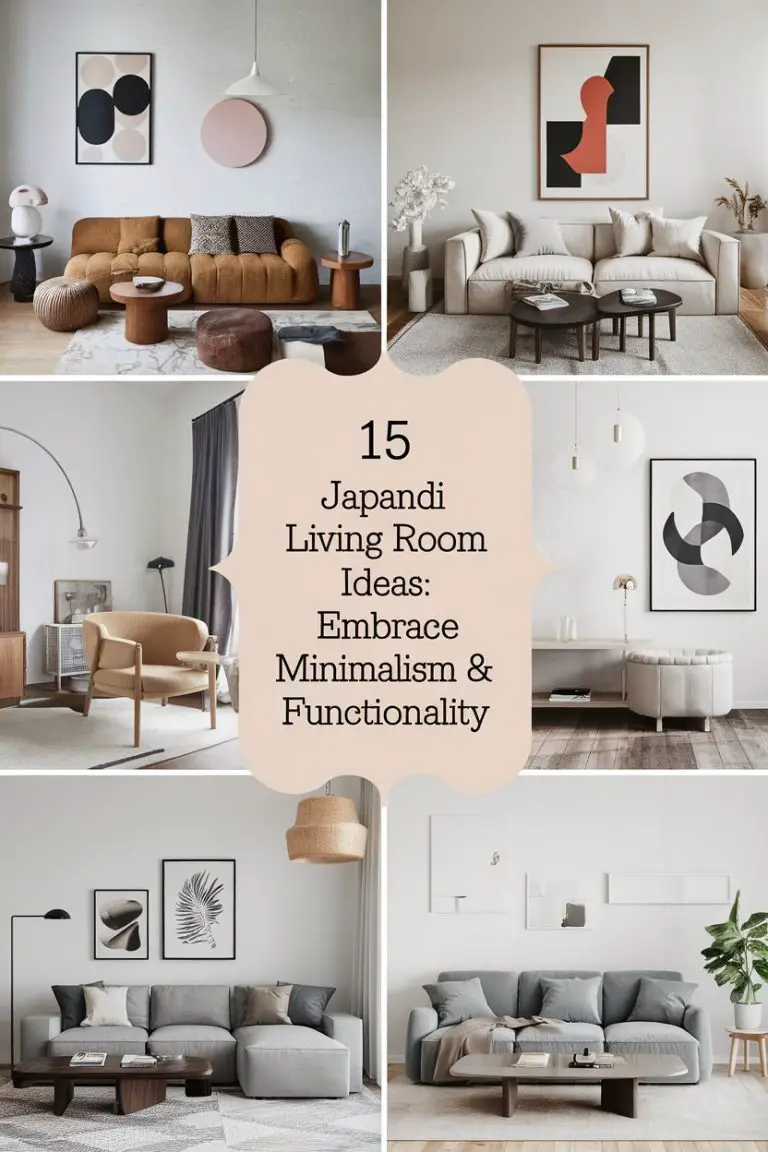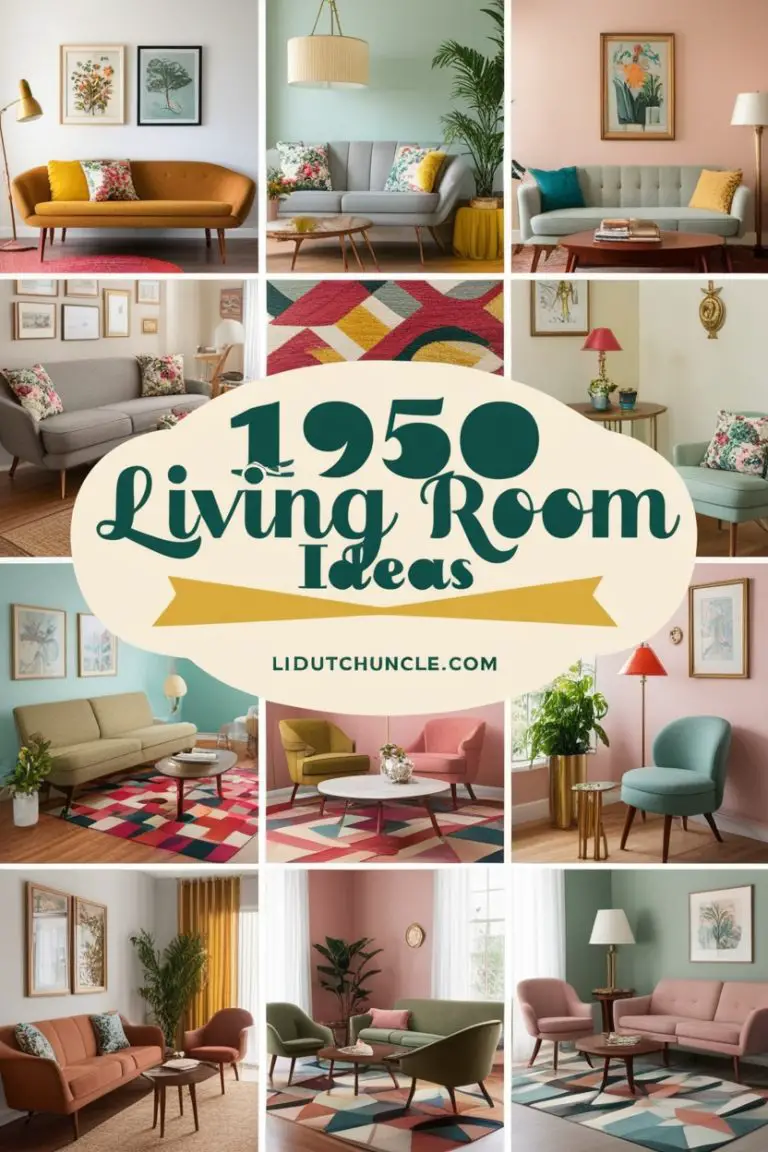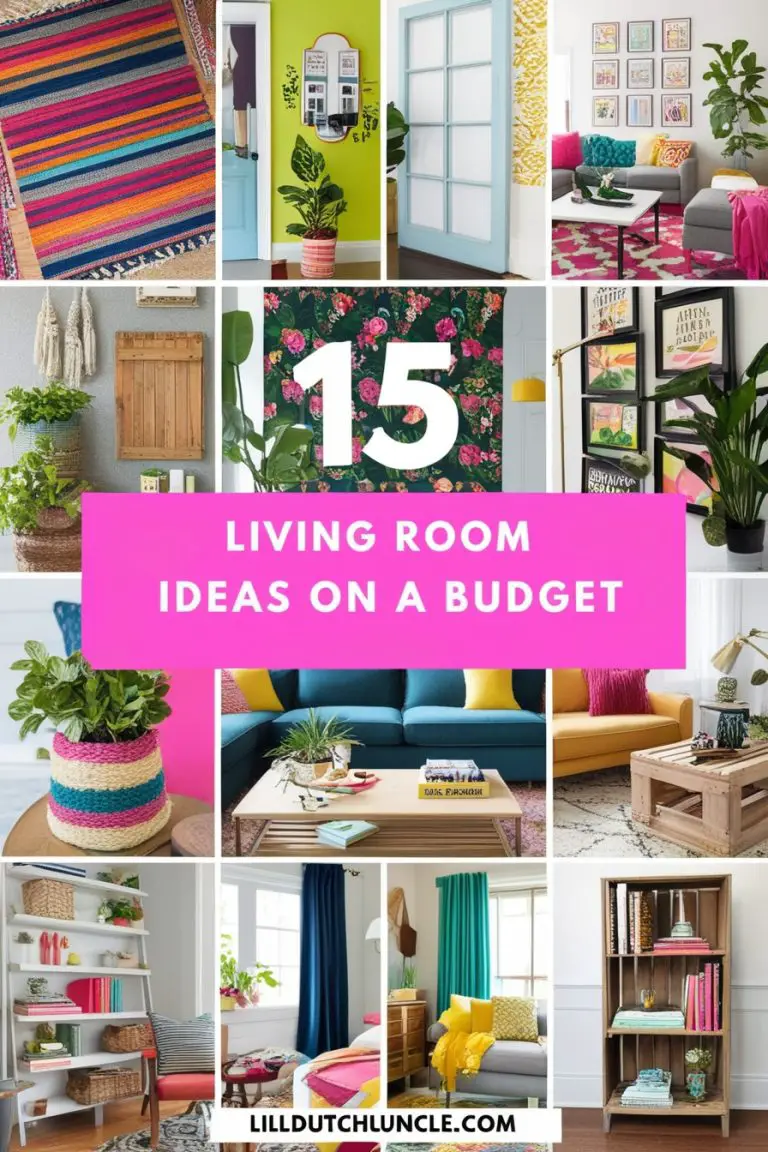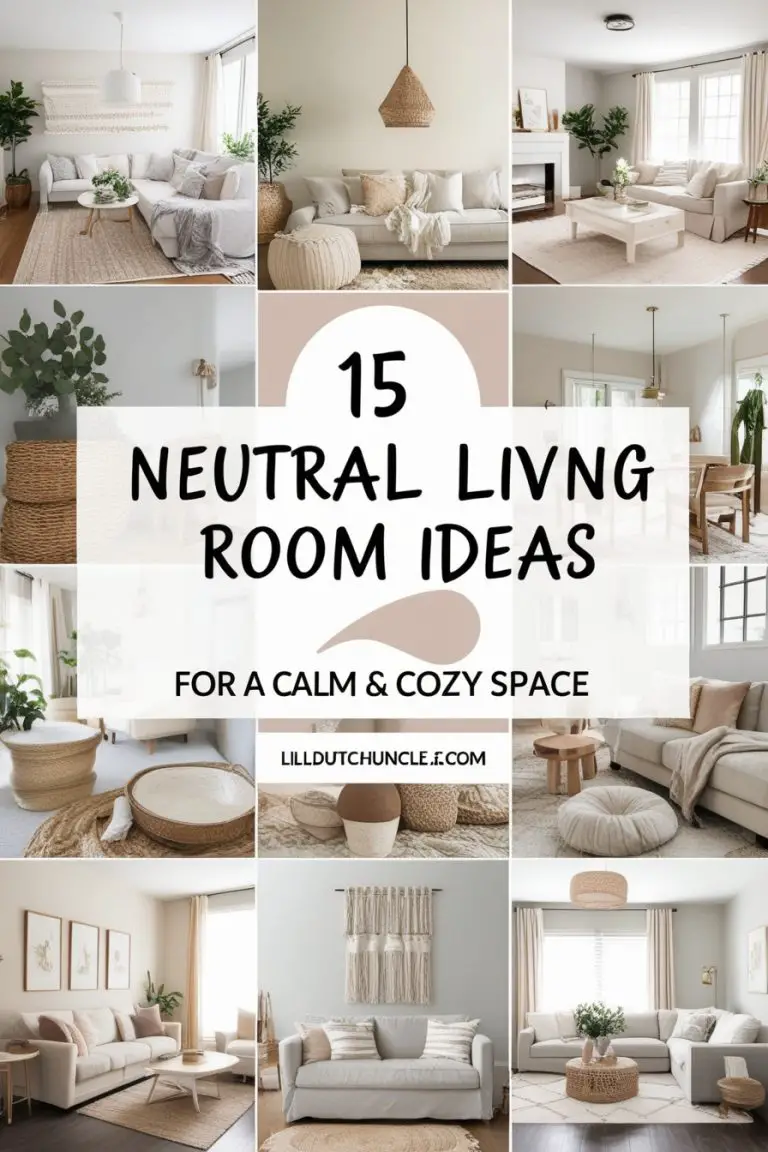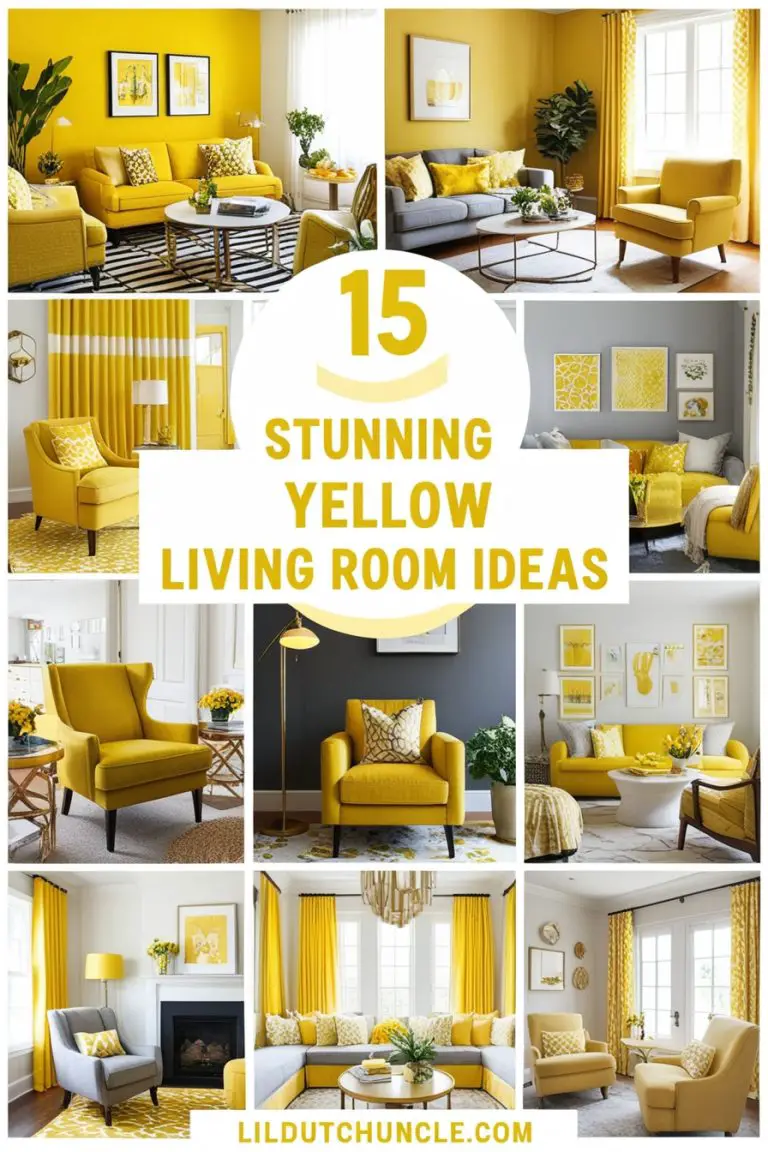Minimalism is a design philosophy focused on simplicity and functionality, where “less is more.” At its core, minimalism promotes a clutter-free, clean, and serene space by using only essential furniture and décor. Minimalist living rooms embody this principle, offering spaces that feel open, light, and intentional.
Key Principles of Minimalist Design:
- Function over Form: Every piece in the room should serve a purpose.
- Declutter: Clear away unnecessary items to emphasize the room’s space.
- Neutral Color Palettes: Soft, muted tones create a calming environment.
- Natural Light: Maximizing light contributes to an airy feel.
Benefits of a Minimalist Living Room:
- Stress Reduction: A clutter-free space promotes a calm mind.
- Easy to Maintain: Fewer items mean less cleaning and organizing.
- Timeless Aesthetic: Minimalist design doesn’t go out of style.
Table of Contents
- Essential Elements of a Minimalist Living Room
- Step-by-Step Guide to Designing a Minimalist Living Room
- 35 Minimalist Living Room Ideas
- 1. Neutral Tones with Wooden Accents
- 2. Large Open Windows
- 3. Floating Shelves
- 4. Low-profile Sofa
- 5. Statement Rug
- 6. Minimalist Gallery Wall
- 7. Monochromatic Color Scheme
- 8. Built-in Storage
- 9. Single Statement Art Piece
- 10. Indoor Greenery
- 11. Open Floor Plan
- 12. Neutral Modular Sofa
- 13. Bare Floors
- 14. Modern Accent Chair
- 15. Minimalist Fireplace Design
- 16. Neutral Throw Pillows
- 17. Glass Coffee Table
- 18. Floor-to-ceiling Curtains
- 19. Exposed Beams
- 20. Simple Floor Lamp
- 21. Concrete Walls
- 22. Light Gray Walls
- 23. Scandinavian Wood Elements
- 24. Leather Accents
- 25. Floating TV Unit
- 26. Minimalist Bookcase
- 27. All-white Living Room
- 28. Metallic Accents
- 29. Mid-century Modern Sofa
- 30. Minimal Ceiling Fan
- 31. Neutral Upholstered Bench
- 32. Natural Light Focus
- 33. Neutral Area Rug
- 34. Large, Minimalist Mirror
- 35. Wooden Ceiling
- Minimalist Living Room Styles
- Minimalist Living Room Furniture Ideas
- Tips for Small Minimalist Living Rooms
- Common Mistakes to Avoid in Minimalist Design
- Conclusion
Essential Elements of a Minimalist Living Room
Creating a minimalist living room requires careful selection of elements that add value without overwhelming the space. Here are the essentials:
- Neutral Color Palettes: Whites, grays, and muted tones are the foundation of minimalist design. They provide a clean backdrop, allowing for occasional pops of color or texture.
- Simple and Functional Furniture: Focus on clean lines, durable materials, and multifunctional furniture, such as a sofa bed or a coffee table with storage.
- Open Space & Airy Layout: Avoid clutter by ensuring that furniture doesn’t overcrowd the room. The space should feel breathable and open.
- Minimal Decorations & Accessories: Less is more when it comes to decoration. Use a single statement piece of art, or add greenery with one or two plants.
- Natural Light: Large windows and sheer curtains are great ways to bring in natural light, which amplifies the minimalist aesthetic.
Step-by-Step Guide to Designing a Minimalist Living Room
Here’s how you can achieve a minimalist living room step by step:
- Declutter and Simplify: Begin by clearing out anything unnecessary. Think about which items serve a functional purpose or bring you joy and eliminate the rest.
- Choose a Color Scheme: Stick to soft, neutral tones for walls, furniture, and decor. Gray, white, beige, and pale earth tones work perfectly to maintain a cohesive look.
- Select Minimalist Furniture: Choose furniture with clean lines and geometric shapes. Opt for pieces that serve more than one function, like storage ottomans or extendable tables.
- Incorporate Textures: While color might be minimal, textures can add richness. Think wood, wool, linen, or stone to add subtle depth.
- Balance with Art & Decor: Add one or two statement pieces that reflect your personal style. Keep it simple, such as a large framed photograph, a single sculpture, or a minimalistic abstract painting.
- Keep it Practical: Comfort and practicality are essential. Choose pieces that are beautiful but functional for your everyday life.
35 Minimalist Living Room Ideas
Here are the 35 inspiring minimalist living room ideas to give a perfect minimalist look to your living space:
1. Neutral Tones with Wooden Accents
Neutral tones form the foundation of minimalist living room design. Soft whites, grays, and beige combined with wooden furniture bring a sense of warmth to the space.
A white or gray sofa paired with a natural wood coffee table creates a soothing contrast, while the wood’s natural grain adds texture without overpowering the room.
To complete the look, consider adding a few understated wooden picture frames or plant pots for a cohesive touch.
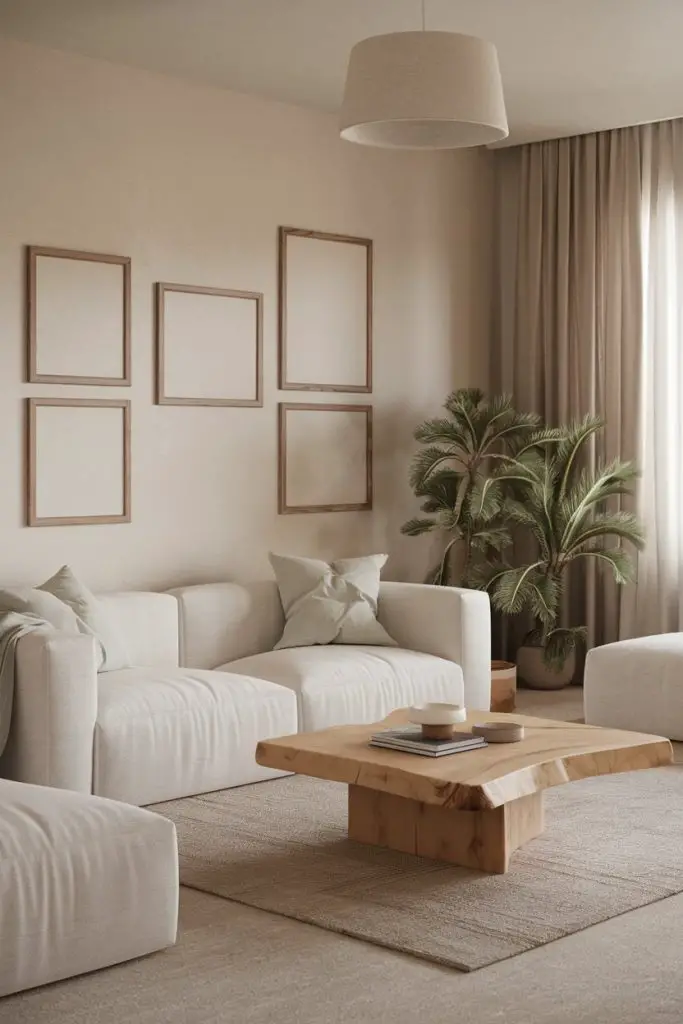
2. Large Open Windows
Natural light plays a huge role in minimalist spaces.
Opt for large, unadorned windows to allow sunlight to flood in. You can use sheer curtains or skip window coverings altogether to enhance the room’s airy feel.
This not only makes the space look larger but also brings a sense of serenity. Maximize the light by keeping your walls light and reflective.
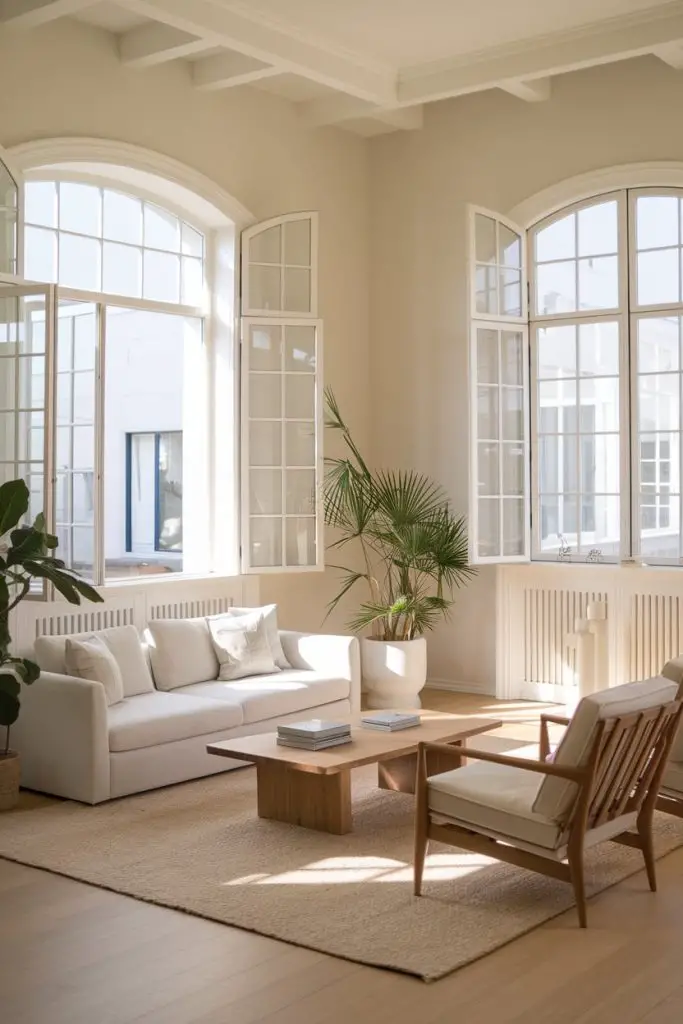
3. Floating Shelves
Floating shelves are a great choice for minimalist homes, offering storage without the need for bulky furniture. Their sleek design keeps your walls looking clean and open.
You can use them to showcase a few simple decor items, like a couple of books or a small plant, adding personality without overwhelming the space. Go for neutral-colored or natural wood shelves that blend effortlessly with your walls.
To maintain that minimalist vibe, keep the items on display low, ensuring your space stays clutter-free and calming.

4. Low-profile Sofa
A low-profile sofa has a sleek, modern look that fits perfectly in minimalist spaces. Its lower height creates a more open feel and avoids blocking sightlines.
Stick to neutral upholstery in tones like beige, gray, or muted pastels. The simple silhouette complements clean, straight lines throughout the room.
Add a single, minimal throw or cushion for comfort without overpowering the design.
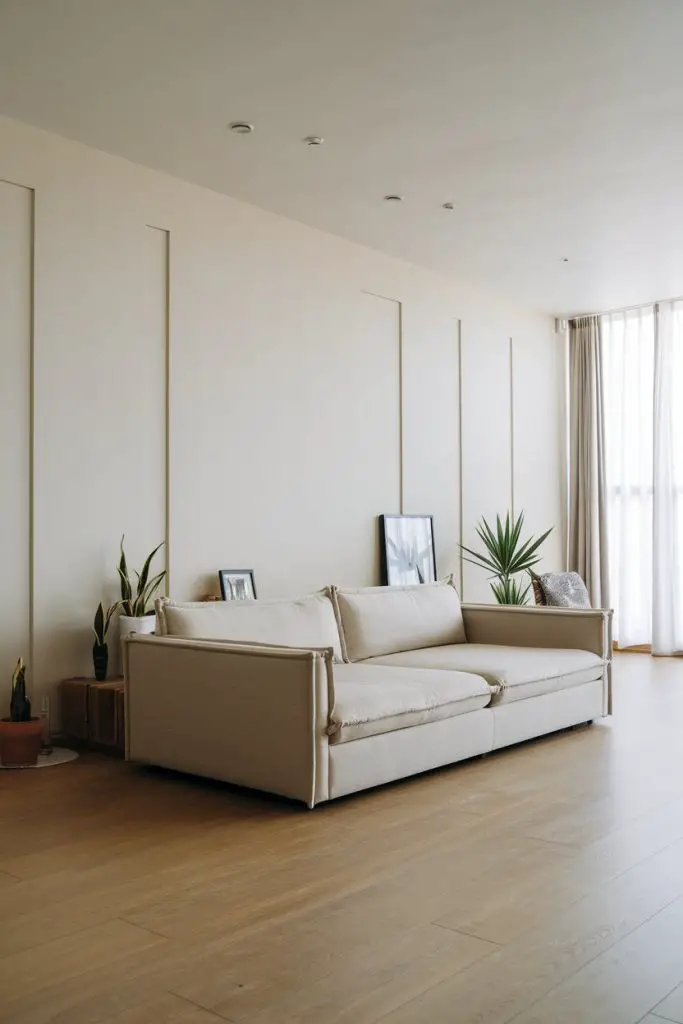
5. Statement Rug
A single statement rug in a minimalist living room can add subtle warmth and texture. Consider neutral colors or soft geometric patterns that align with the room’s palette.
The goal is for the rug to pull the space together without stealing the spotlight. Opt for natural materials like wool or jute to add an earthy feel.
Keep the design simple and understated to preserve the room’s clean, uncluttered vibe.
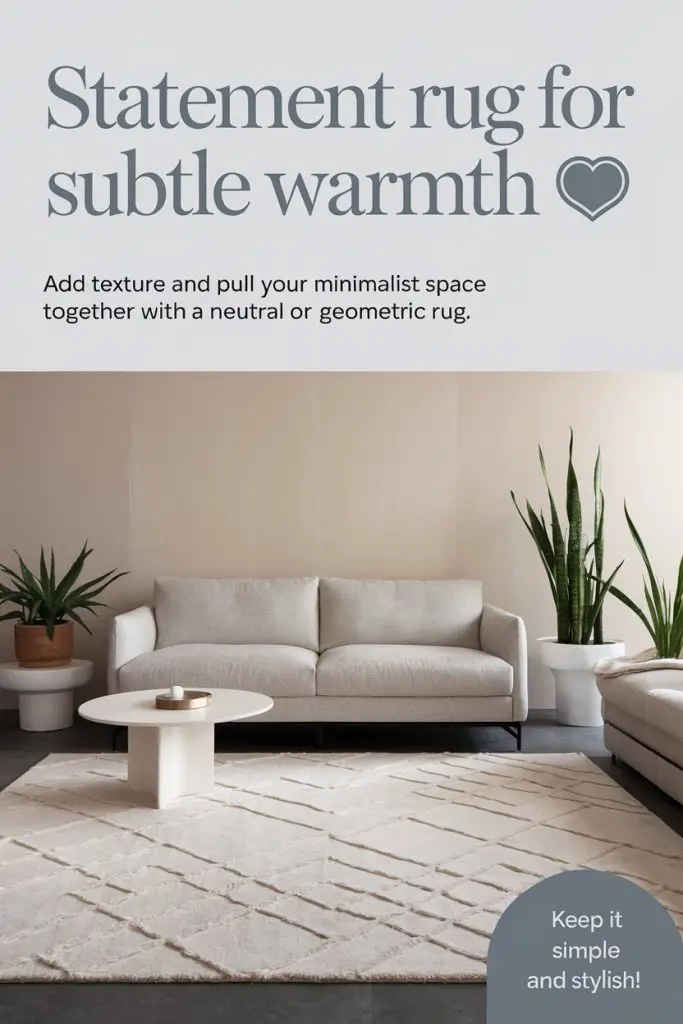
6. Minimalist Gallery Wall
You can create a minimalist gallery wall by using a small collection of neutral or monochrome art pieces.
Stick to thin, understated frames that won’t distract from the art itself. Arrange them symmetrically for a clean, organized look. Keep the colors within a consistent palette, such as black and white or muted tones.
Limit the number of pieces to avoid making the wall too busy.
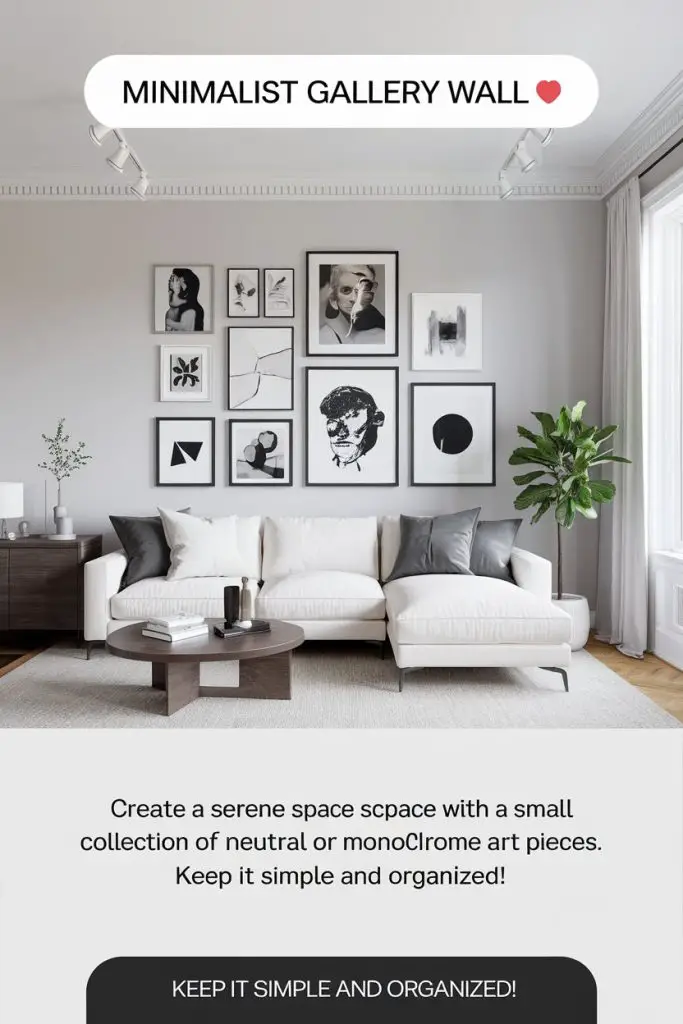
7. Monochromatic Color Scheme
A monochromatic color scheme is a great way to simplify the look of your living room.
By sticking to one color family, like different shades of gray or beige, you create a smooth, unified flow throughout the space. Each piece can vary slightly in tone, but keeping everything within the same hue helps maintain balance.
The beauty of this approach lies in its simplicity, giving the room a serene and cohesive feel.
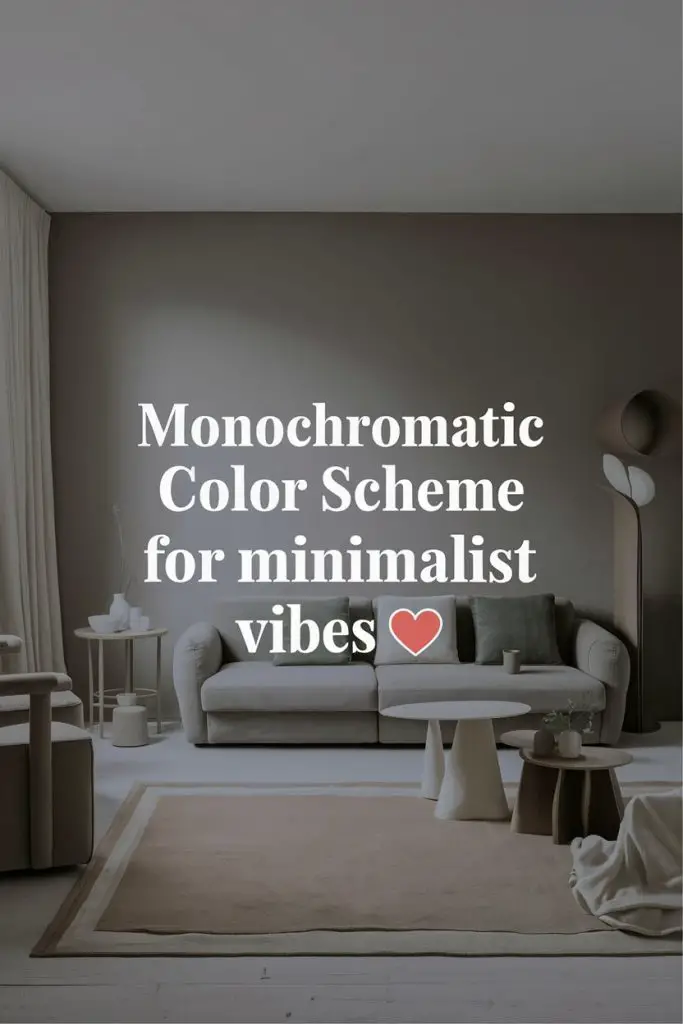
8. Built-in Storage
Built-in storage solutions are a minimalist’s best friend. They offer hidden space for items, maintaining a clutter-free environment.
Cabinets that blend into the walls keep the room looking sleek. The smooth, flat surfaces of built-ins ensure that no bulky furniture disturbs the flow of the room.
Use them to store everyday essentials out of sight, giving your room a streamlined appearance.
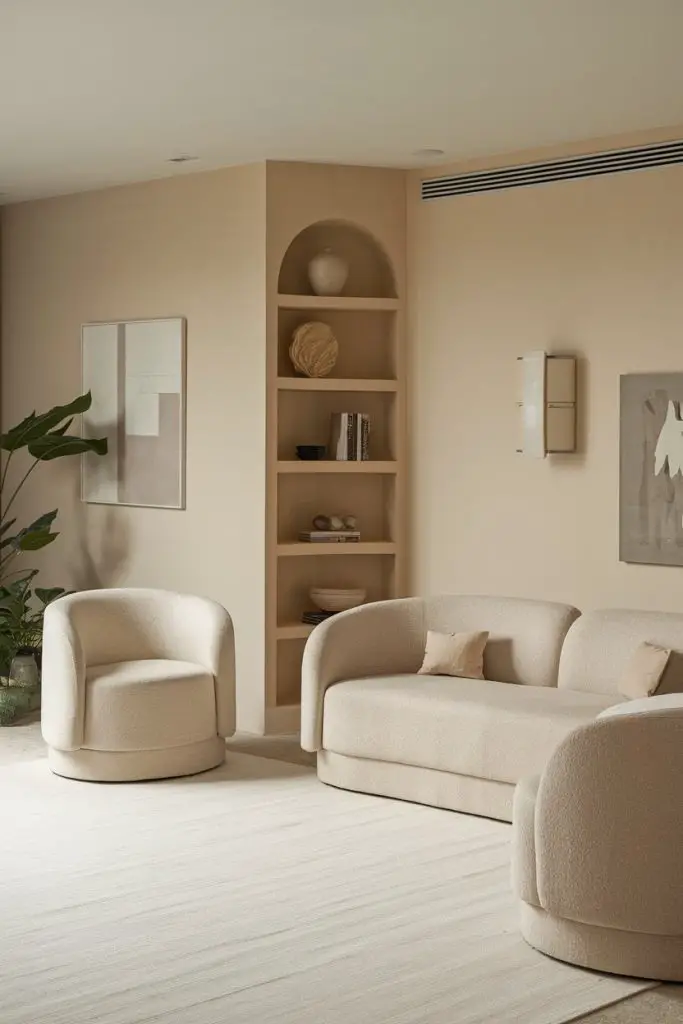
9. Single Statement Art Piece
In minimalist design, one large art piece often makes a stronger impact than several smaller ones.
Choose an artwork that resonates with you but has a simple, neutral color palette. Hang it on an uncluttered wall to let it truly stand out.
This single focal point can anchor the room without overwhelming it. A monochrome or abstract piece works particularly well.
10. Indoor Greenery
A single potted plant can add life and color to a minimalist living room without cluttering it.
Plants like snake plants or fiddle-leaf figs work well for their architectural shapes. Keep the planter simple and neutral to blend with the room’s design.
Limit yourself to one or two plants to maintain a clean, minimalist look. Their natural green adds contrast against neutral walls without being too bold.
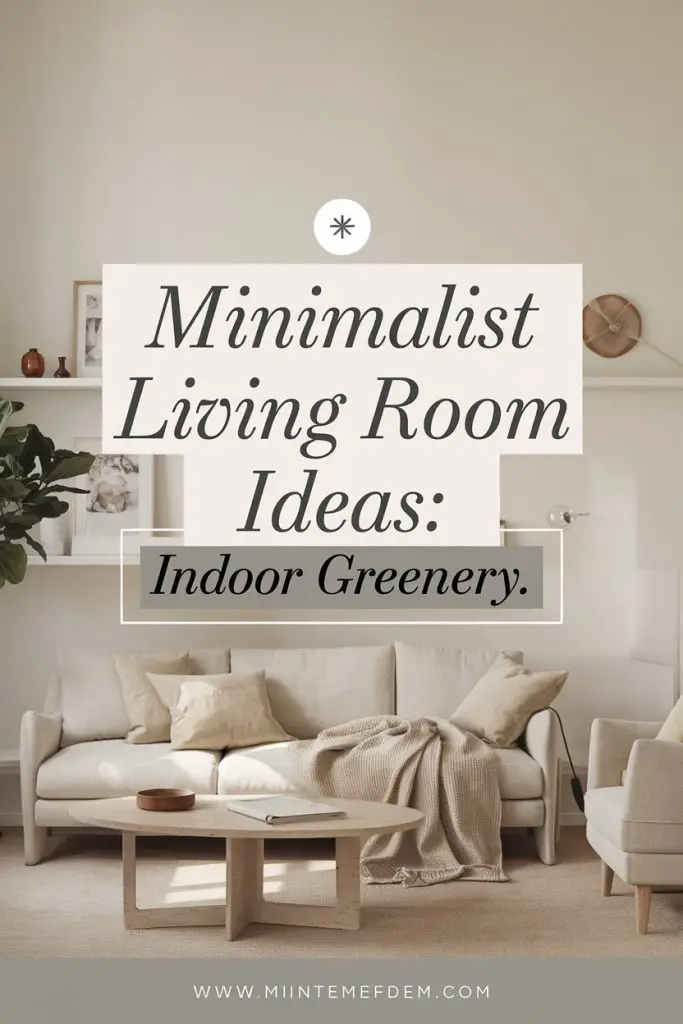
11. Open Floor Plan
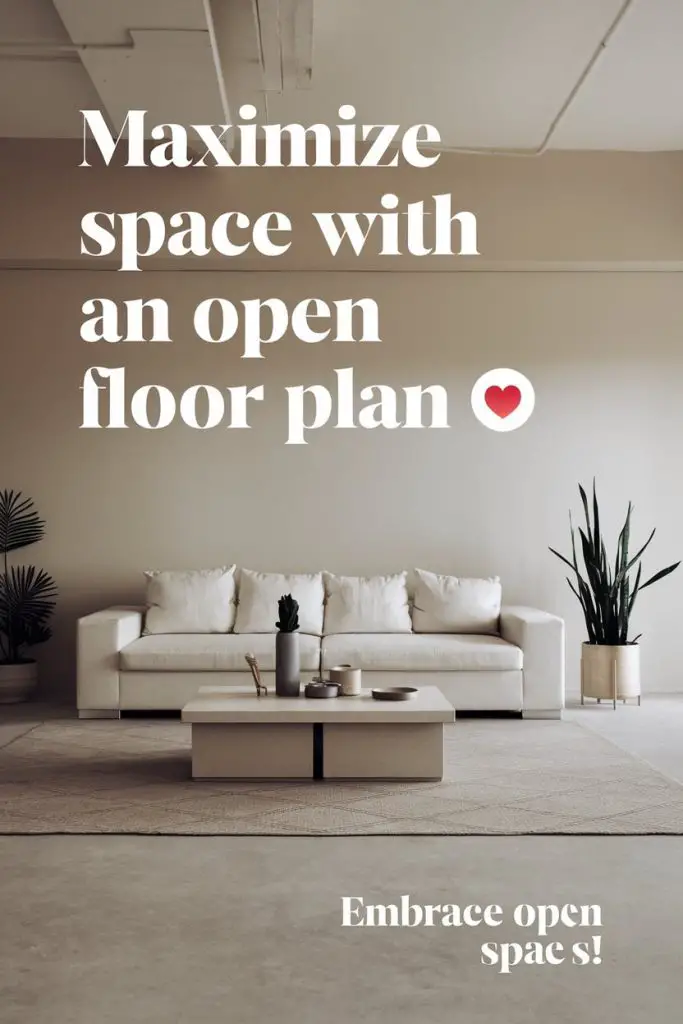
An open floor plan enhances the feeling of space and flow in a minimalist living room. Keep furniture to a minimum and arrange it to create clear, unobstructed walkways. This setup allows for greater flexibility in how you use the room. Avoid placing large pieces in the middle of the room, which can block the open feel. The key is to embrace space, not fill it.
12. Neutral Modular Sofa
Modular sofas are great for minimalist spaces due to their versatility. Choose a design in a neutral tone that can be rearranged to suit your needs.
This flexibility allows you to change the layout without adding new pieces.
Go for clean lines and smooth fabrics to complement the room’s minimalist style. Keep decorative pillows and throws minimal to maintain the sofa’s sleek look.
13. Bare Floors
In minimalist design, sometimes less is more—even when it comes to flooring. Skip the rug and let your hardwood or concrete floors shine.
Bare floors contribute to the clean and open feel of a minimalist living room. If the floor material is natural, like wood or polished stone, it adds texture without overwhelming the space. Keep the floors clean and polished for an elegant finish.
14. Modern Accent Chair
A single modern accent chair can add character to a minimalist living room.
Look for a design with clean lines, sleek legs, and a simple silhouette. Upholstery should be neutral, with fabrics like linen or leather complementing the rest of the room. Place it in a corner or as a companion to your sofa without crowding the space.
The chair can stand out as a functional yet stylish piece.
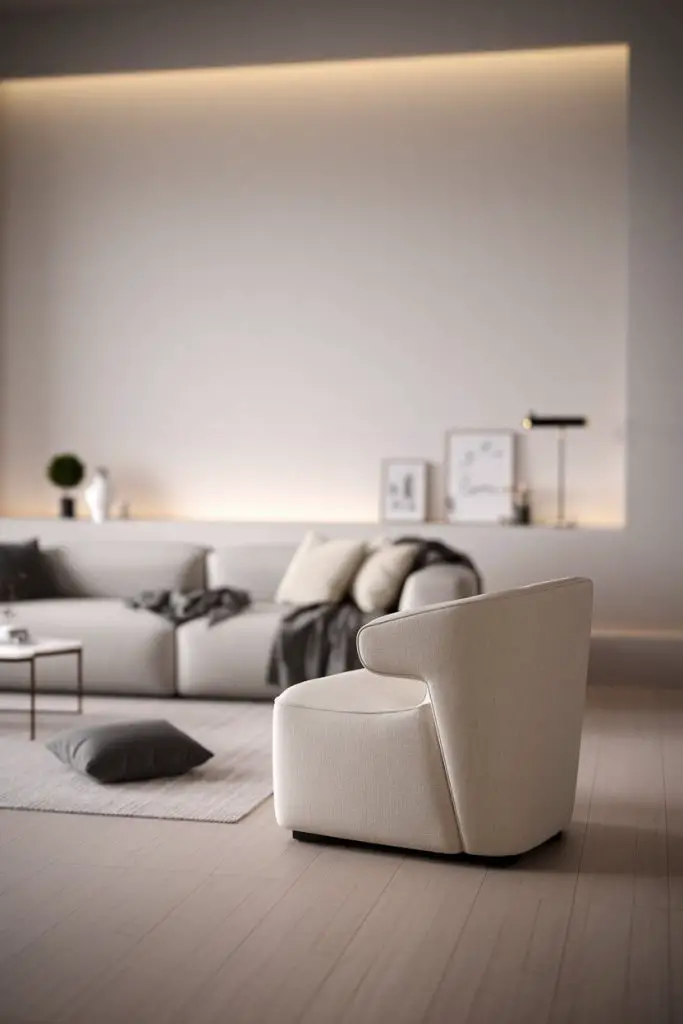
15. Minimalist Fireplace Design
If you have a fireplace, keep it simple with smooth, clean lines and minimal decoration.
A stone or concrete surround gives a sleek, modern touch. Avoid over-decorating the mantle—stick to a single vase or a few candles.
The fireplace should blend seamlessly with the room without overpowering the minimalist aesthetic. It can serve as a subtle focal point, providing warmth and comfort.
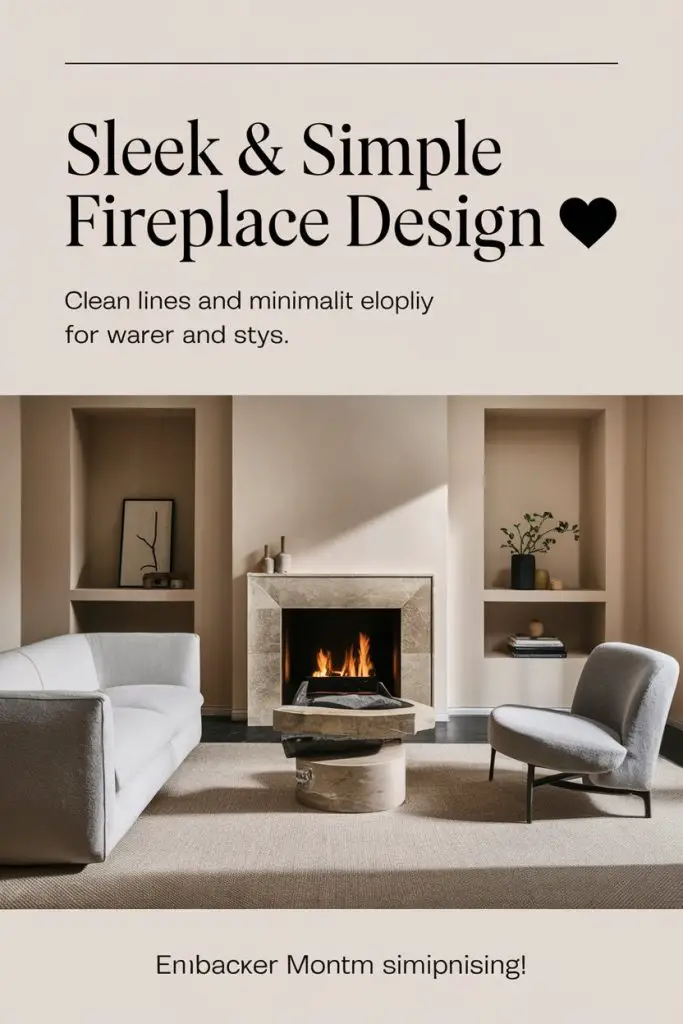
16. Neutral Throw Pillows
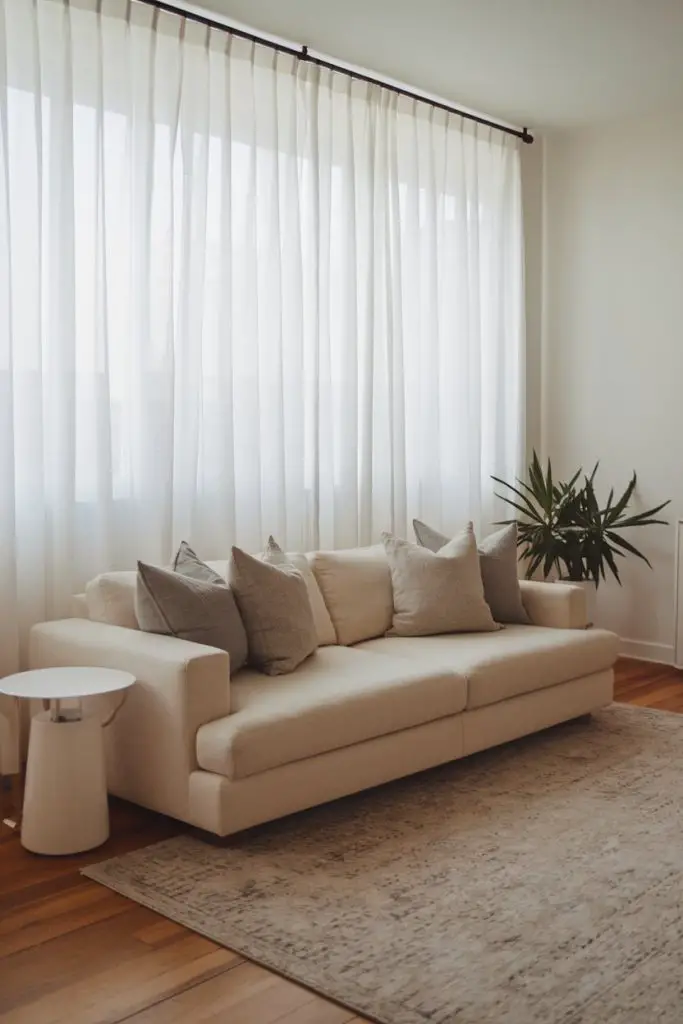
Stick to neutral, solid-colored throw pillows that complement your sofa without adding too much detail. Go for simple fabrics like cotton, wool, or linen in shades that match your room’s color scheme. Keep the number of pillows minimal to avoid visual clutter, and try mixing one or two different sizes or shapes for a bit of variety. This small touch adds comfort while keeping the minimalist vibe intact.
17. Glass Coffee Table
A glass coffee table is a great way to create the illusion of more space in a minimalist living room. Its transparent surface keeps the room feeling open, as it doesn’t obstruct the view.
Opt for one with clean, simple lines, steering clear of bulky or overly ornate designs. The reflective quality of glass also helps to brighten the space by bouncing light around.
Keep the decor on the table minimal—perhaps a small plant or a single book—to maintain that airy, uncluttered look.
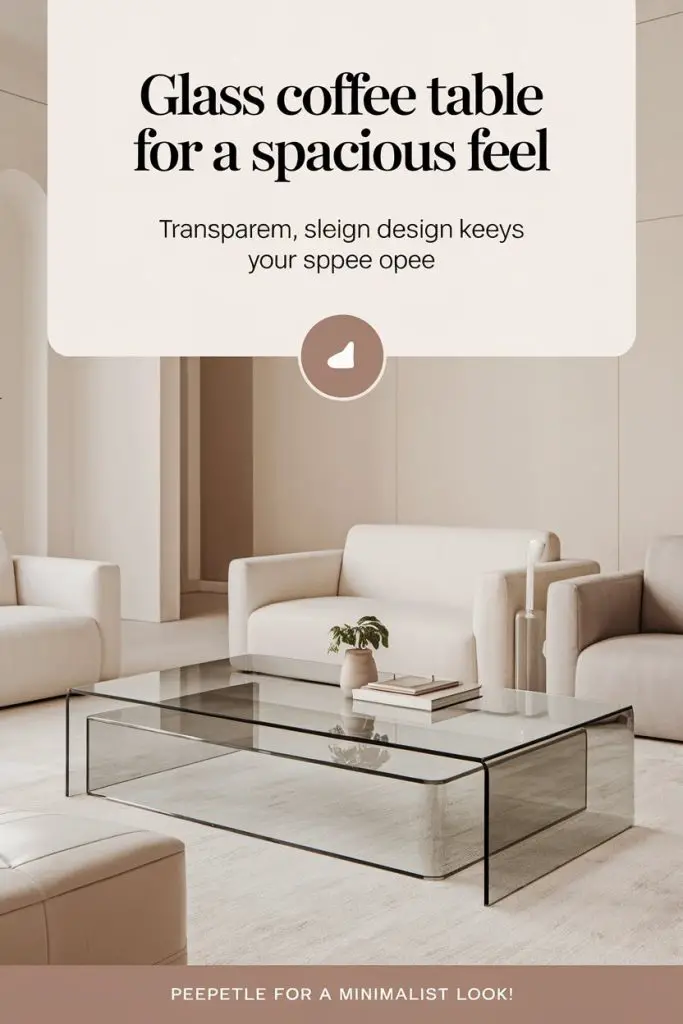
18. Floor-to-ceiling Curtains
Floor-to-ceiling curtains in a light, neutral fabric can make your living room feel taller and more open.
Choose materials like linen or cotton that add softness without overpowering the space. Keep the color muted, matching the walls for a seamless look.
These curtains add elegance while still adhering to minimalist principles. The vertical lines they create also help elongate the room visually.
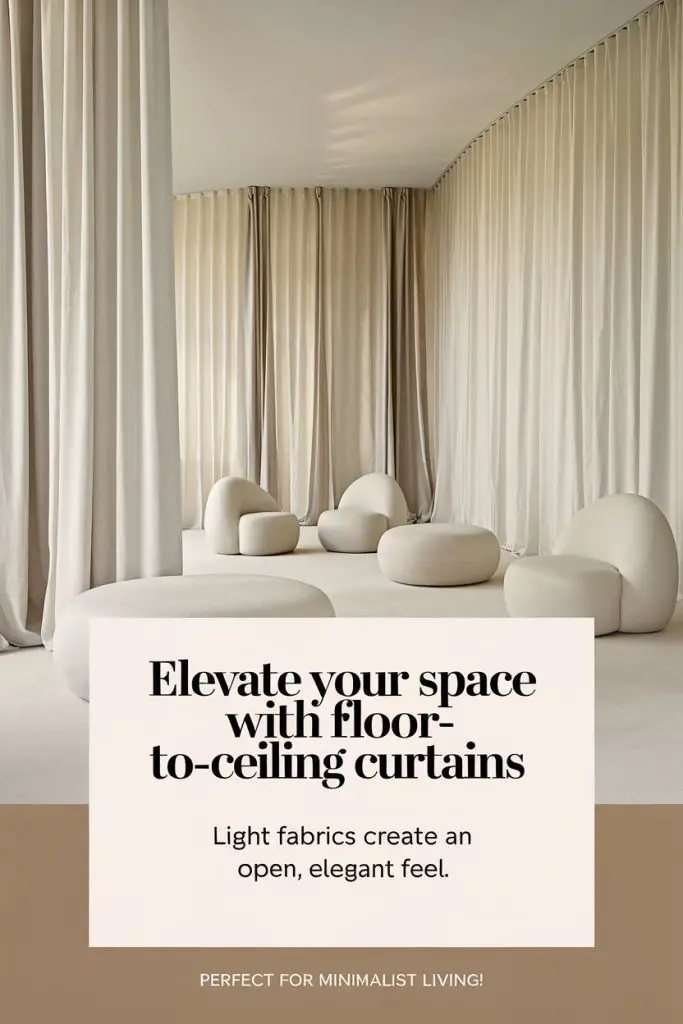
19. Exposed Beams
If your living room has exposed ceiling beams, embrace them as a feature of minimalist design.
Natural wood beams add warmth and texture to an otherwise neutral room. Keep the rest of the decor simple to let the beams stand out.
Use light-colored furniture to contrast the darker beams. The combination of natural materials and open space creates a rustic-modern feel.
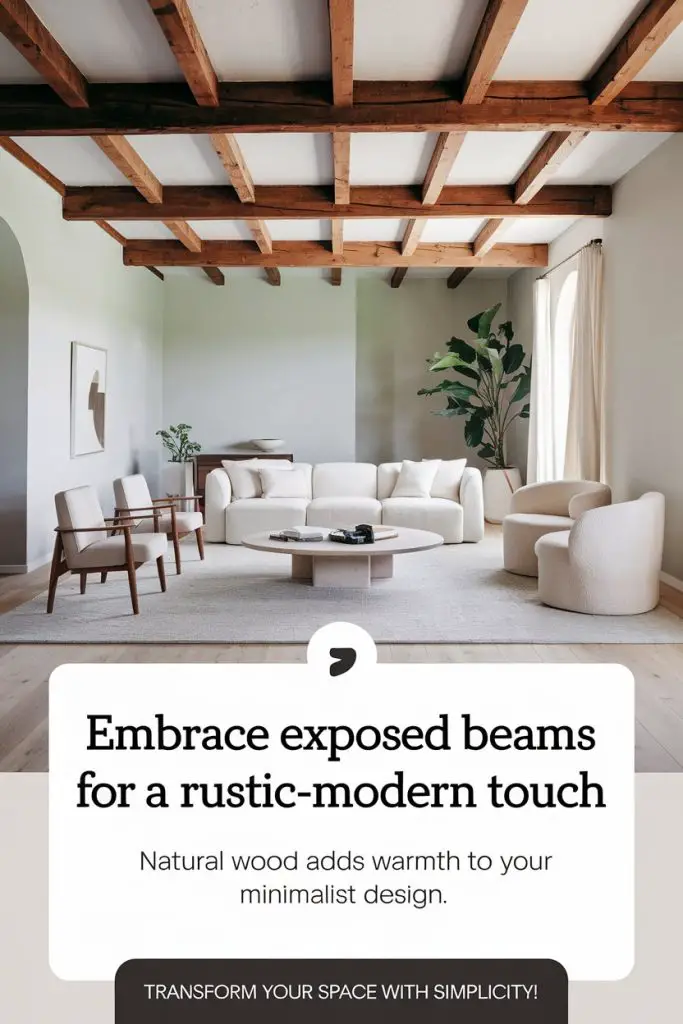
20. Simple Floor Lamp
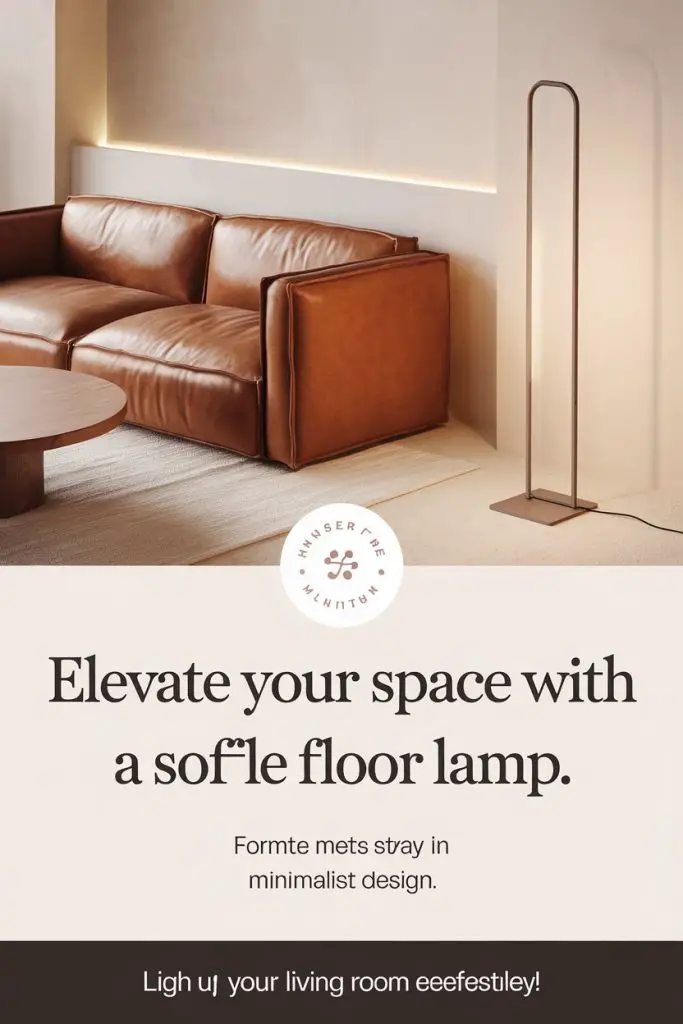
A minimalist floor lamp can provide both function and style without overwhelming the space. Choose a sleek, streamlined design in metal or matte finishes. The lamp should have clean lines and a simple base, avoiding ornate details. Place it in a corner or next to the sofa to provide soft, ambient lighting. The lamp will add height to the room without taking up much space.
21. Concrete Walls
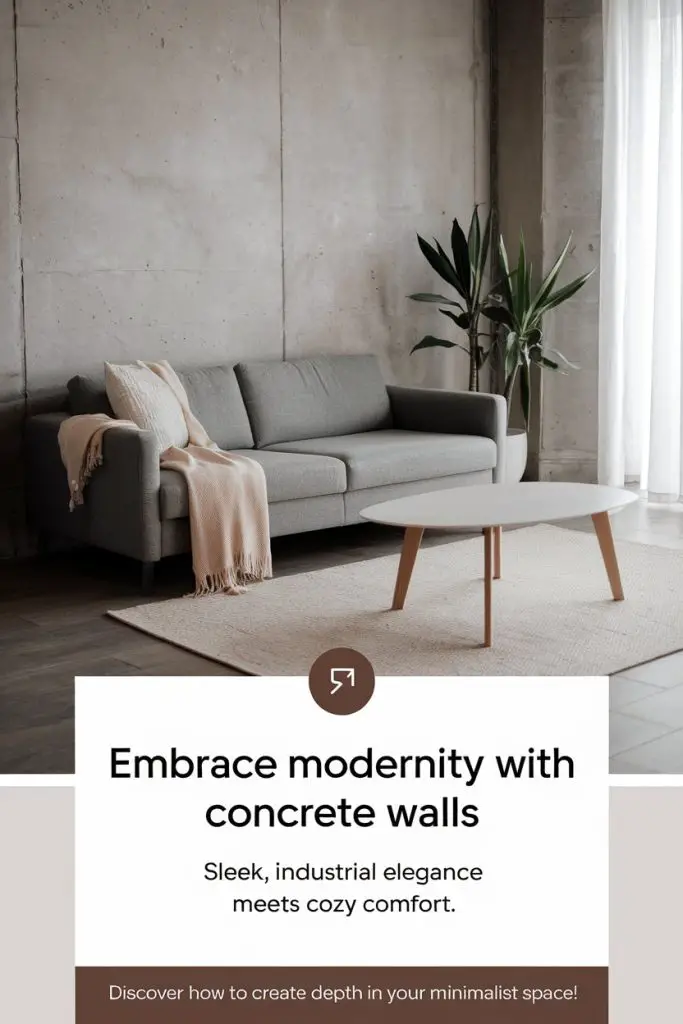
Concrete walls add a modern-industrial edge to minimalist spaces. Their smooth, neutral surface provides a sleek backdrop without demanding attention.
Pair concrete with soft textiles, like wool or cotton throws, to balance the coolness of the material. You can leave the walls bare or hang one minimalist art piece for added texture.
This combination of raw and refined elements gives the room depth without losing its simplicity.
22. Light Gray Walls

Light gray is an ideal wall color for minimalist living rooms. It’s softer than white but still provides a neutral backdrop that blends well with various materials. The color adds a hint of warmth while keeping the space airy and open. Pair light gray walls with white or beige furniture to create a calming atmosphere. Gray’s understated tone allows other design elements, like wooden accents or greenery, to subtly stand out.
23. Scandinavian Wood Elements
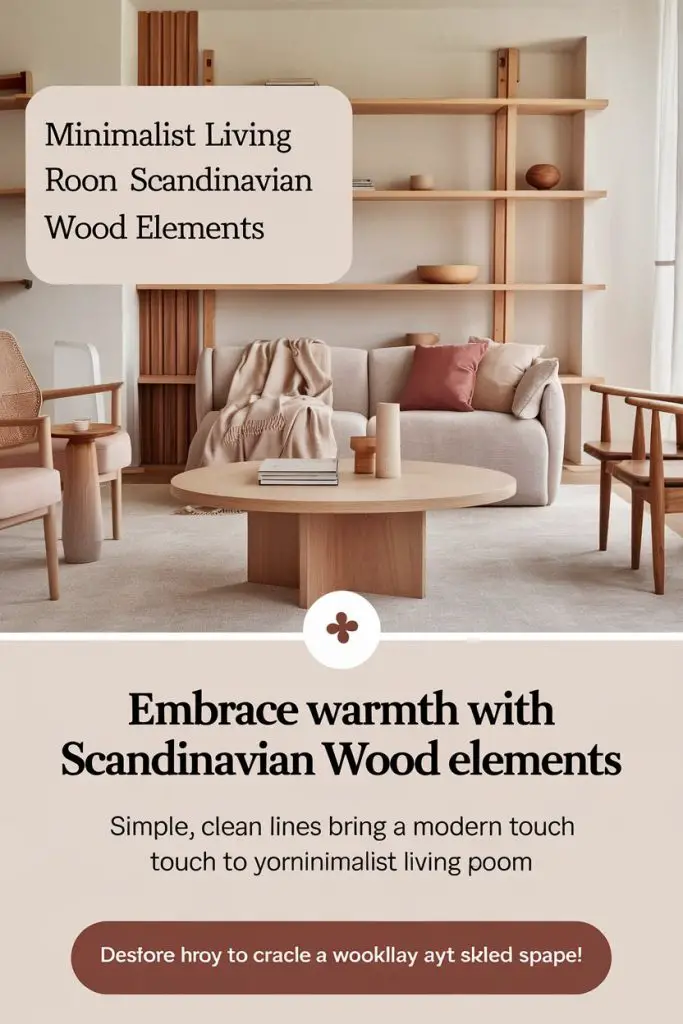
Incorporating Scandinavian wood furniture brings warmth to a minimalist living room. Light, natural wood like ash or pine works best in keeping with the minimalist aesthetic. Stick to simple, clean-lined furniture pieces such as coffee tables, chairs, or shelving units. These wood tones complement neutral walls and add a subtle texture. The combination of wood and soft, minimalist textiles creates a welcoming yet modern feel.
24. Leather Accents
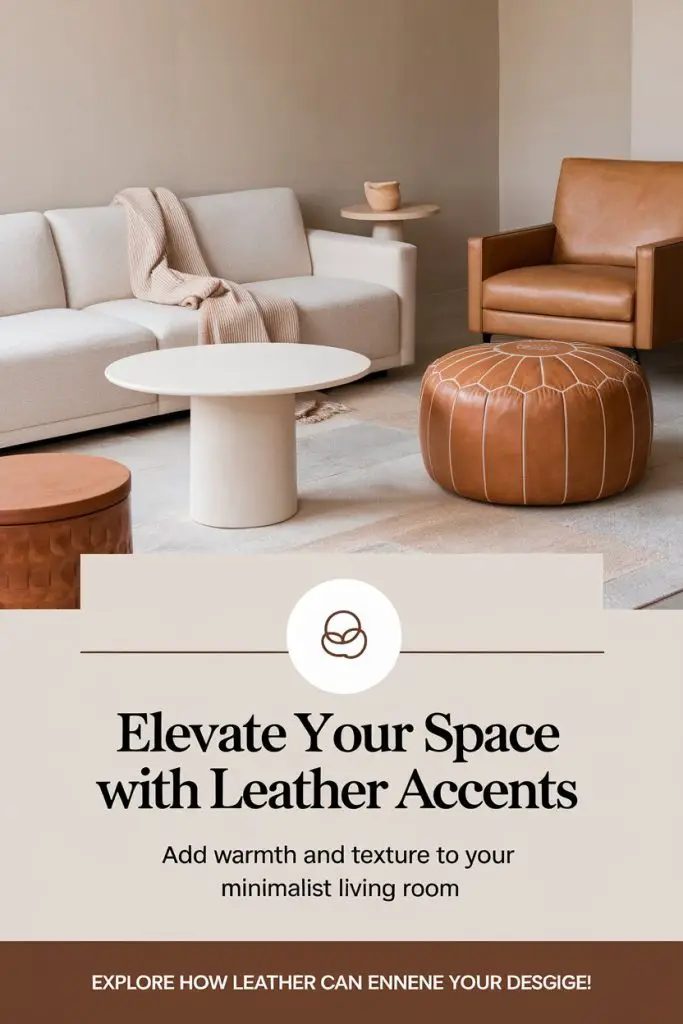
Leather accents, such as a chair, ottoman, or cushions, add richness to a minimalist living room. Opt for tan or cognac leather, which provides warmth without overpowering the space. A single leather chair in a neutral-colored room adds texture and contrast. Pair it with light textiles like a cotton or linen throw for balance. Leather ages gracefully, adding character over time while maintaining its sleek appearance.
25. Floating TV Unit
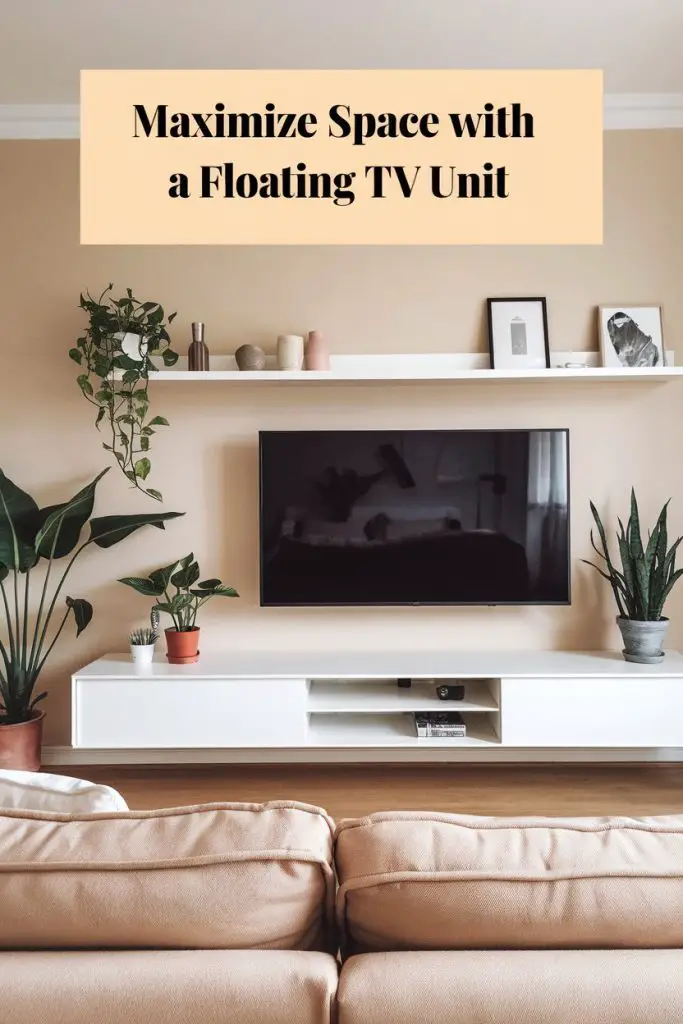
A floating TV unit creates the illusion of more space by keeping the floor area clear. Its clean, modern design aligns with minimalist principles. Choose one in a neutral tone or light wood finish that blends with the walls. Use the unit to store electronics and accessories out of sight, maintaining a clutter-free look. The floating aspect adds a sense of lightness to the room while still providing practical storage.
26. Minimalist Bookcase
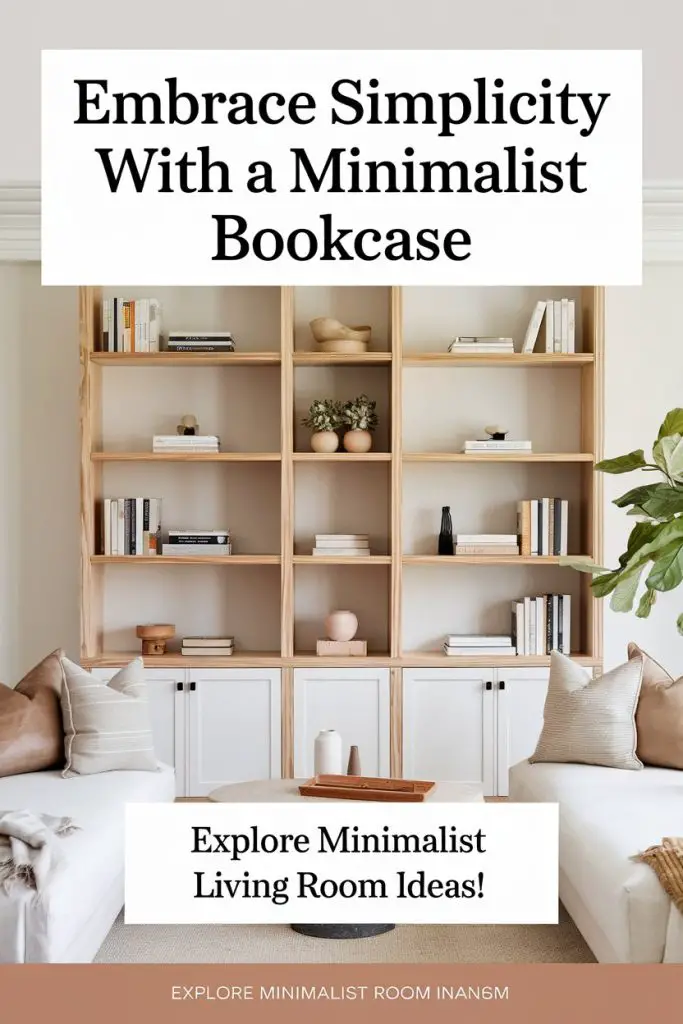
A minimalist bookcase should feature simple lines and a lightweight frame, avoiding bulk. Choose a design in natural wood or metal, with shelves that are either open or glass-fronted for an airy feel. Limit the items you display—stick to a few carefully chosen books, plants, or neutral-toned decor pieces. Avoid overcrowding the shelves to keep the space looking clean. The key is to let each item on the shelf breathe, enhancing the minimalist aesthetic.
27. All-white Living Room
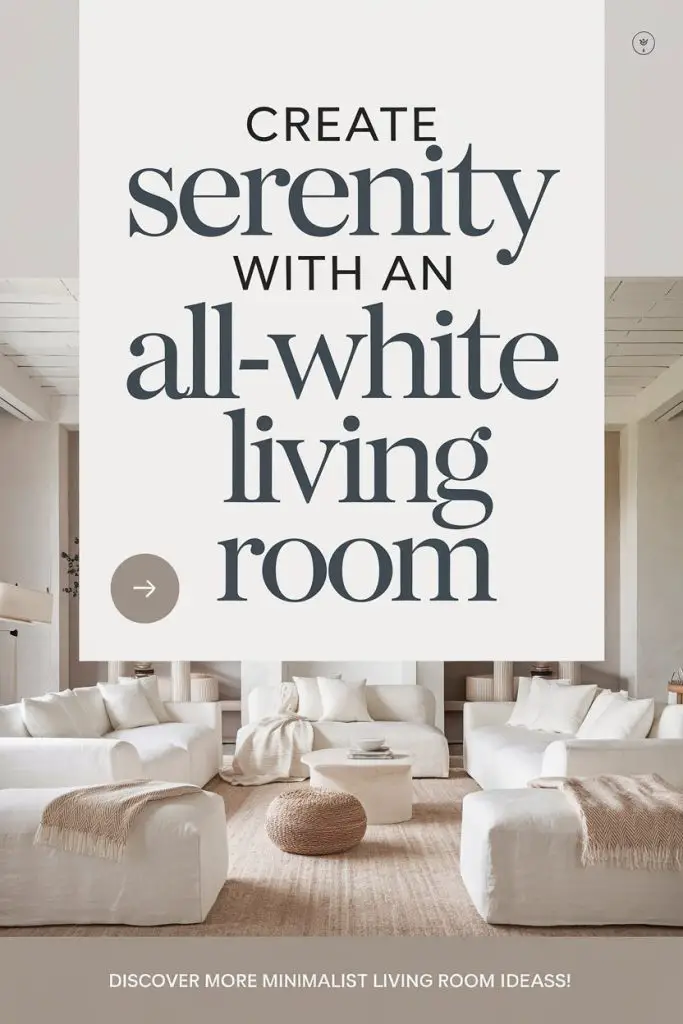
An all-white living room creates a bright, serene atmosphere, perfect for minimalist design. Vary textures and materials to keep the space from feeling cold or sterile. Use white linen sofas, woolen throws, and cotton rugs to add warmth and softness. Accent with neutral-toned furniture or subtle wooden elements for depth. The simplicity of an all-white palette keeps the room calm and uncluttered, allowing light to reflect and open up the space.
28. Metallic Accents
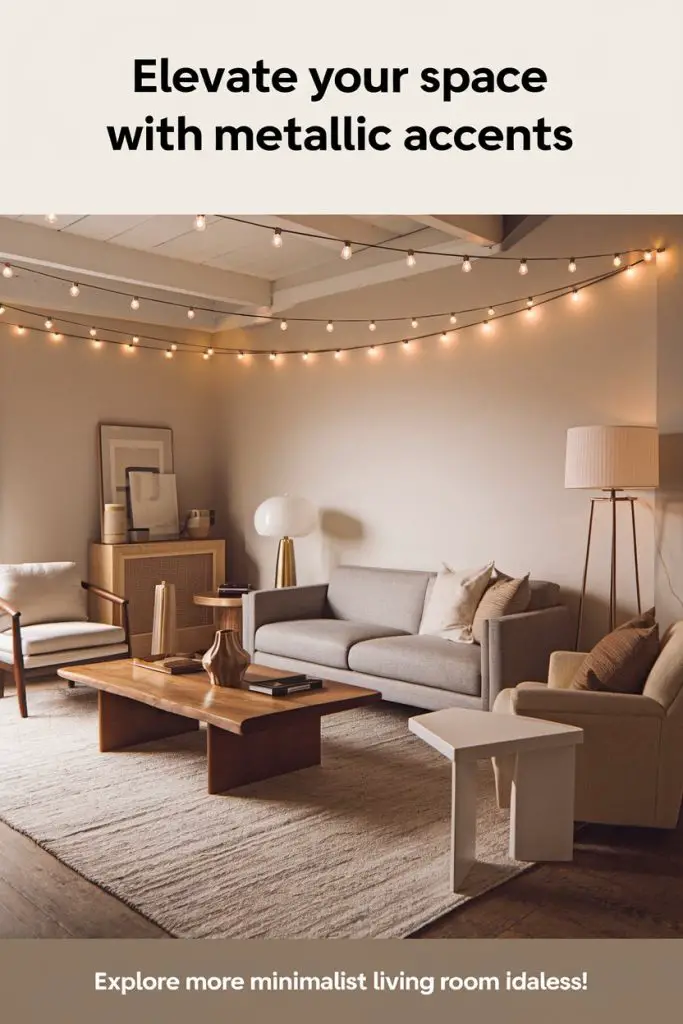
Metallic accents, like a brass table lamp or stainless-steel legs on furniture, can add a touch of luxury to a minimalist space. Stick to subtle, matte finishes rather than shiny or ornate metals. A small metal frame, side table, or candle holder can introduce a sleek, modern touch. The metallic elements should complement the room’s color scheme without overpowering it. Incorporating metals in small doses keeps the design elegant yet understated.
29. Mid-century Modern Sofa

A mid-century modern sofa with a minimalist design works well in contemporary minimalist living rooms. Look for a sofa with straight lines, simple legs, and neutral upholstery. The low profile and clean silhouette fit effortlessly into a minimalist space. Pair the sofa with minimal throw pillows in neutral tones for a cohesive look. The balance between function and style makes mid-century modern furniture a perfect match for minimalism.
30. Minimal Ceiling Fan

A ceiling fan with a sleek, modern design can enhance the functionality of your minimalist living room. Opt for a fan with clean lines and minimal detailing, in neutral colors like black, white, or gray. It should complement the room’s decor without drawing too much attention. The right fan not only keeps the space cool but also adds a subtle, modern accent. Keep the surrounding decor simple to allow the fan to blend into the background.
31. Neutral Upholstered Bench
A neutral-colored upholstered bench can provide extra seating without adding bulk to the room. Opt for soft fabrics like linen or cotton in beige, gray, or taupe tones. The clean, simple design of a bench makes it a versatile piece that can be moved easily when needed. Place it against a wall or at the foot of the sofa for added functionality. The minimalist silhouette keeps the room looking spacious and organized.
32. Natural Light Focus
Maximize the natural light in your living room by arranging furniture to avoid blocking windows. Place seating near the light source to create a welcoming, bright area. Light walls, curtains, and furniture reflect sunlight, enhancing the room’s airy feel. Avoid heavy curtains or dark furniture that could dim the space. Focusing on natural light helps create a calm, open atmosphere central to minimalist design.
33. Neutral Area Rug
A neutral area rug in soft beige, cream, or gray tones helps anchor the living room without overwhelming it. The rug adds warmth and texture, especially if you have bare floors like hardwood or concrete. Choose one with a simple design or no pattern at all to maintain the minimalist aesthetic. The rug should complement the room’s palette and enhance the sense of calm. Its texture can subtly define the seating area without dominating the space.
34. Large, Minimalist Mirror
A large, minimalist mirror can make a small living room feel more open and spacious. Opt for one with a thin, neutral frame that blends into the wall. Placing the mirror opposite a window will reflect natural light and brighten the room. It can serve as a subtle focal point without adding any visual clutter. Mirrors also help create the illusion of more space, perfect for minimalist interiors.
35. Wooden Ceiling
Incorporating natural wood elements in the ceiling adds warmth and texture to a minimalist room. A wooden ceiling can provide a rustic contrast to the clean lines and neutral tones of the space. Keep the wood in its natural state or use light finishes to maintain the minimalist aesthetic. Pair the ceiling with simple furniture and neutral decor to balance the room. The wood introduces a natural, earthy element while still adhering to the principles of minimalism.
Minimalist Living Room Styles
There are various substyles within minimalist living room design, each with its own unique take on simplicity:
- Scandinavian Minimalism: Light wood, clean lines, and cozy accents like throws and pillows. It balances minimalism with warmth.
- Modern Minimalism: Think sleek surfaces, metals, glass, and bold contrasts. It’s sharper and more dramatic.
- Japanese Minimalism: Focused on natural elements like wood and earth tones, it emphasizes balance, simplicity, and the outdoors.
- Industrial Minimalism: Exposed elements like brick or metal combined with minimal furniture, often in raw or unfinished forms.
- Boho Minimalism: A minimalist base with earthy tones, natural textures, and eclectic accents to create a warm yet pared-down space.
Minimalist Living Room Furniture Ideas
Choosing the right furniture is key to creating a cohesive minimalist living room. Here are some ideas:
- Best Couches for Minimalist Spaces: Look for compact, multifunctional designs. Neutral colors with clean lines or a modular sofa that can be rearranged work well.
- Coffee Tables: Opt for simple geometric shapes made from natural materials like wood, marble, or metal. A coffee table with built-in storage can be both functional and aesthetic.
- Storage Solutions: Look for built-in shelves or furniture with hidden compartments. Wall-mounted shelving can reduce floor clutter and maintain open space.
- Rugs and Lighting Choices: Stick to neutral, textured rugs that add warmth without overpowering the room. For lighting, minimalist floor lamps or simple pendant lights can create the right mood.
Tips for Small Minimalist Living Rooms
If you have a smaller living room, you can still embrace minimalist design while maximizing space:
- Maximize Space: Use multifunctional furniture like sofa beds or foldable tables. Consider wall-mounted shelves or storage to save floor space.
- Create the Illusion of Space: Mirrors are excellent for making a room appear larger, especially when placed opposite windows to reflect natural light.
- Space-saving Furniture Options: Choose furniture with clean lines that don’t visually overcrowd the room. Opt for lighter, legged pieces that create the illusion of more floor space.
Common Mistakes to Avoid in Minimalist Design
Even in a minimalist living room, there are common pitfalls to be aware of:
- Over-decluttering: While minimalism focuses on simplicity, it’s important to maintain a comfortable, lived-in feel. Don’t strip away too much personality.
- Sticking to Just White: Incorporate a range of soft hues and warm tones to avoid making your room feel cold or sterile.
- Under-utilizing the Space: Ensure you don’t leave too much empty space, which can make the room feel incomplete or barren.
- Ignoring Functionality for Aesthetics: Make sure every piece is functional. A beautiful chair might look great, but it should also be comfortable.
Conclusion
Minimalist living room design is about creating a calming, organized space that is both functional and aesthetically pleasing.
By focusing on quality over quantity, using neutral colors, maximizing natural light, and incorporating only the essentials, you can transform your living room into a serene retreat.
Embrace minimalism to simplify your space and improve the quality of your daily life.
Related Articles:

Jenny is a passionate writer specializing in home decor, design, and styling. With years of experience in transforming spaces, she shares expert tips on creating beautiful, functional homes. From interior design trends to DIY decor ideas, Jenny’s work helps homeowners craft spaces that reflect their unique style. Whether it’s a cozy living room, a modern kitchen, or a serene bedroom, her articles offer practical advice and inspiration to elevate any home.
